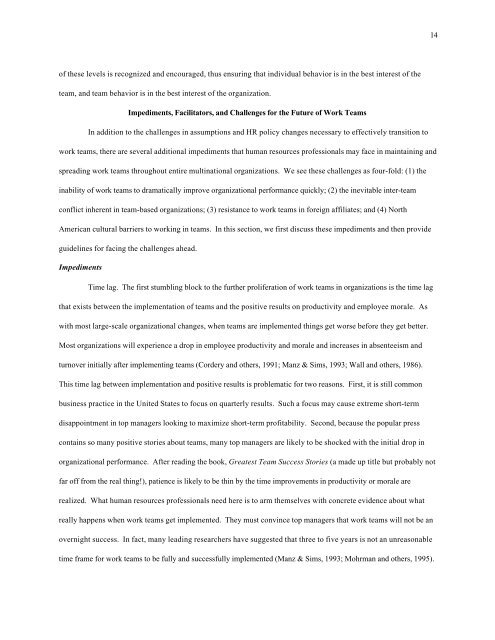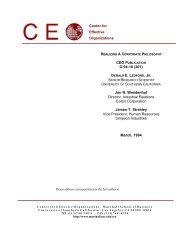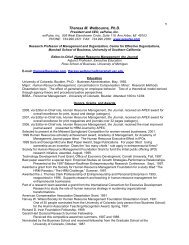Our Past, Present, and Future in Teams - Center for Effective ...
Our Past, Present, and Future in Teams - Center for Effective ...
Our Past, Present, and Future in Teams - Center for Effective ...
You also want an ePaper? Increase the reach of your titles
YUMPU automatically turns print PDFs into web optimized ePapers that Google loves.
14of these levels is recognized <strong>and</strong> encouraged, thus ensur<strong>in</strong>g that <strong>in</strong>dividual behavior is <strong>in</strong> the best <strong>in</strong>terest of theteam, <strong>and</strong> team behavior is <strong>in</strong> the best <strong>in</strong>terest of the organization.Impediments, Facilitators, <strong>and</strong> Challenges <strong>for</strong> the <strong>Future</strong> of Work <strong>Teams</strong>In addition to the challenges <strong>in</strong> assumptions <strong>and</strong> HR policy changes necessary to effectively transition towork teams, there are several additional impediments that human resources professionals may face <strong>in</strong> ma<strong>in</strong>ta<strong>in</strong><strong>in</strong>g <strong>and</strong>spread<strong>in</strong>g work teams throughout entire mult<strong>in</strong>ational organizations. We see these challenges as four-fold: (1) the<strong>in</strong>ability of work teams to dramatically improve organizational per<strong>for</strong>mance quickly; (2) the <strong>in</strong>evitable <strong>in</strong>ter-teamconflict <strong>in</strong>herent <strong>in</strong> team-based organizations; (3) resistance to work teams <strong>in</strong> <strong>for</strong>eign affiliates; <strong>and</strong> (4) NorthAmerican cultural barriers to work<strong>in</strong>g <strong>in</strong> teams. In this section, we first discuss these impediments <strong>and</strong> then provideguidel<strong>in</strong>es <strong>for</strong> fac<strong>in</strong>g the challenges ahead.ImpedimentsTime lag. The first stumbl<strong>in</strong>g block to the further proliferation of work teams <strong>in</strong> organizations is the time lagthat exists between the implementation of teams <strong>and</strong> the positive results on productivity <strong>and</strong> employee morale. Aswith most large-scale organizational changes, when teams are implemented th<strong>in</strong>gs get worse be<strong>for</strong>e they get better.Most organizations will experience a drop <strong>in</strong> employee productivity <strong>and</strong> morale <strong>and</strong> <strong>in</strong>creases <strong>in</strong> absenteeism <strong>and</strong>turnover <strong>in</strong>itially after implement<strong>in</strong>g teams (Cordery <strong>and</strong> others, 1991; Manz & Sims, 1993; Wall <strong>and</strong> others, 1986).This time lag between implementation <strong>and</strong> positive results is problematic <strong>for</strong> two reasons. First, it is still commonbus<strong>in</strong>ess practice <strong>in</strong> the United States to focus on quarterly results. Such a focus may cause extreme short-termdisappo<strong>in</strong>tment <strong>in</strong> top managers look<strong>in</strong>g to maximize short-term profitability. Second, because the popular pressconta<strong>in</strong>s so many positive stories about teams, many top managers are likely to be shocked with the <strong>in</strong>itial drop <strong>in</strong>organizational per<strong>for</strong>mance. After read<strong>in</strong>g the book, Greatest Team Success Stories (a made up title but probably notfar off from the real th<strong>in</strong>g!), patience is likely to be th<strong>in</strong> by the time improvements <strong>in</strong> productivity or morale arerealized. What human resources professionals need here is to arm themselves with concrete evidence about whatreally happens when work teams get implemented. They must conv<strong>in</strong>ce top managers that work teams will not be anovernight success. In fact, many lead<strong>in</strong>g researchers have suggested that three to five years is not an unreasonabletime frame <strong>for</strong> work teams to be fully <strong>and</strong> successfully implemented (Manz & Sims, 1993; Mohrman <strong>and</strong> others, 1995).
















